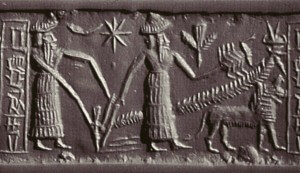
Sumer: Alien life in lyrics
 2
2
 09. 10. 2023
09. 10. 2023

In 1849, English archaeologist and explorer Sir Austen Henry Layard found himself among the ruins of ancient Babylon in southern Mesopotamia. It was there that he discovered the first fragments of what had become one of the most controversial puzzles of archeology - the cuneiform tables. In this ancient text, there are stories that mysteriously resemble biblical stories of creation, deities, and even mention the Great Flood and the huge ark as a refuge from it. Experts have spent decades deciphering these complex symbols. One of the more interesting aspects of wedge writing is the development of characters from the original pictograms of the Sumerian language to the wedge-shaped strokes of the Akkadian and Assyrian writing.
The controversial researcher and writer Zecharia Sitchin came up with the idea that this ancient civilization knew about distant star systems and was in contact with extraterrestrial life. In his book, Ancient Alien Theory, he attributes the beginnings of Mesopotamian society to a type of being known as the Anunnaki, who came from the distant 12th planet of Nibiru.
The Gods among us
The most frequently discussed topic of tables for archaeologists is the origin of the Anunnaki. Stories are officially considered metaphors about creation. Mentions of the Anunnaki, but with many names altered or otherwise, can be found in other texts, especially in the book of Genesis in the Jewish and Christian religions. There is no doubt that the stories of the creation of "heaven and earth", the idea of creation as an image of a higher being, as well as the well-known stories of Adam and Eve or Noah's ark tell mysteriously similar depictions of the origin of our species. But the question is, are these tables older than the Bible, which elements of these stories are myths, and how much truth is in them.
There is a line of thought that concludes that not only does the planet Nibiru exist, but also that the Anunnaki were a powerful alien species capable of genetic experimentation and manipulation. The convincing nature of these arguments is also supported by the recent finding by scientists that a global catastrophe in the form of a flood probably occurred some 10000 years ago. There could be a great decline in the human population, and civilization began to re-emerge from scratch. Was there an "ark" or a ship that could save a small percentage of the population for the later emergence of a new civilization? If so, was it an metaphor of an alien spaceship or a real wooden ship? Proponents of Sitchin's line of thought claim that if they were metaphors, then they described the technology of these powerful beings.
Where are they now?
The question remains: If our species was the result of a genetic experiment of extraterrestrial civilization, where are our creators now? Almost 31000 of these old clay tablets are now stored in the British Museum, and most of them have not yet been translated. Many of the texts are only fragmentary and incomplete and make it impossible to understand the whole.
Interestingly in wedge script, over the course of several thousand years, the way language is written has changed dramatically from the early form of pictograms to the reinterpretation of ancient characters into wedge-shaped notches in several later Mesopotamian civilizations, and there is no uniform rule for translation.
In the picture, we see an example of wedge writing, which allowed the writer to effectively use one instrument by pushing it into a soft clay table from right to left. As languages evolved, so did scripture, and between 4000 and 500 BC, the meanings of the words changed to reflect the influence of the Semites who conquered Mesopotamia. In its original form, the pictogram could have different meanings depending on the context. Over time, the font changed more and more and the number of characters decreased from 1500 to 600.
But why Earth?
Sitchin takes an unusual view of the reason for the presence of the Anunnaki here on Earth. According to his research, these beings "evolved after Nibiru entered the solar system and first came to Earth, probably 450000 years ago. They were looking for minerals here - mainly gold, which they also found and mined in Africa. Sitchin claims that these "gods" were ordinary workers of a colonial expedition sent from the planet Nibiru to Earth. "
Academics and respected archaeologists around the world have rejected this theory as absurd. There are many theorists dealing with ancient aliens who reject Sitchin's theories for lack of empirical evidence, and his translation of the tables is not recognized by many wedge experts.
Nevertheless, some modern researchers believe that parts of Sitchin's work are justified and could help translate other tables and create context for names and stories about ancient people. Among these new researchers is Michael Tellinger, who believes he has found compelling evidence to support Sitchin's unsubstantiated claims from the last century. Tellinger argues that there is evidence of gold mining in parts of South Africa and that some of the references in Sitchin's translations of Sumerian texts could relate to real places in this part of the world with monuments and megalithic structures that coincide with the stories.






